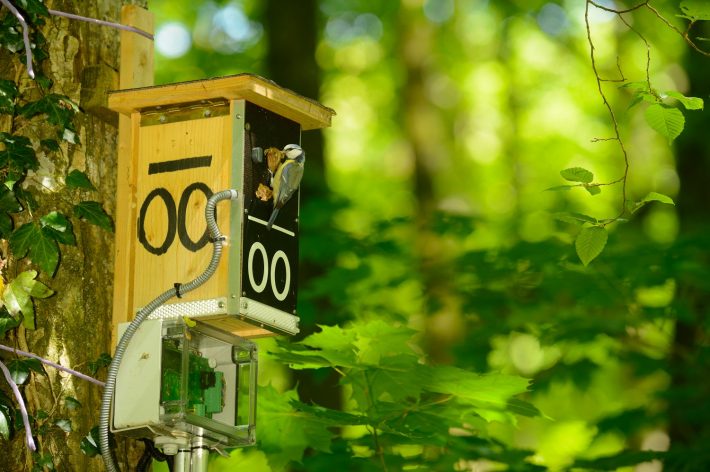First come, first bred
Max Planck Institute for Ornithology press release.
Arriving early in the breeding area is crucial for successful reproduction in non-migratory birds find research published in Journal of Animal Ecology.

In birds, timing of arrival in a breeding area influences who ends up breeding and who does not. This aspect of behaviour, well-known in migratory birds, has now been studied for the first time in a non-migratory species, the blue tit.
Researchers at the Max Planck Institute for Ornithology in Germany found that arrival time in the breeding area was an individual-specific and fitness-relevant trait for this resident bird species, as early-arriving individuals were more likely to breed in that year. The study suggests that it might be worthwhile to consider migration on different scales, not only as movements over thousands of kilometres to wintering grounds, but also more generally as movements between breeding and non-breeding sites.
For migratory birds, early arrival in spring in the breeding area increases the likelihood of getting a mate and/or a high-quality territory, and therefore increases breeding success. However, early-arriving birds may face harsher environmental conditions that might offset the benefits, as they lead to a higher mortality risk. For non-migratory or year-round resident species, the timing of arrival in the breeding area and its effect on reproductive success has not been considered previously, perhaps because it is assumed that most individuals stay in the local area also during the non-breeding season.
The blue tit is a partial migrant in the northern part of its range but is considered to be non-migratory in the rest of Europe. In a study site in Southern Germany, researchers from the Max Planck Institute for Ornithology installed a self-designed, custom-built automated monitoring system that registered all visiting blue tits throughout the year.
Individuals could be “followed” because they carried a “Passive Integrated Transponder” (PIT-tag). The PIT tag is a tiny tag with an individual code that is activated externally by a scanning device present in 16 feeders and all 277 nest boxes in the study area. With this setup, the researchers could record the date, time, and identity of every PIT-tagged blue tit visit and thus estimate the arrival date of all adult individuals in the study site.
After breeding ended in June, blue tits stopped visiting the nestboxes for several months. Many individuals were first registered again either at a feeder or at a nestbox in autumn (between August and October). Another arrival peak occurred in winter (January-March).
“The data suggest that some individuals may have been true residents, staying in the study site during winter, while others left the area during the non-breeding season
– says Carol Gilsenan, first author of the study.
Difference in arrival date of former pair members explained the occurrence of divorce
Although arrival dates were highly variable between individuals – spanning roughly eight months –, the researchers were surprised to find that the same individuals arrived around the same time each year. Generally, males arrived earlier in the breeding area than females, and birds that bred together arrived around the same time in the study site. However, a previous study of the research group showed that blue tits did not patiently wait for their mate from last year to return: if the former partner did not arrive within about a week after their own arrival, the probability of divorce strongly increased. “In a short-lived species such as the blue tit, individuals that would decide to wait for their former partner to return may risk not breeding at all,” explains Gilsenan.
The researchers found that early-arriving individuals had a higher chance to breed and that the timing of arrival predicted several aspects of the birds’ breeding success. How far the blue tits went outside the study site and where they stayed during the winter months remains unclear, but Bart Kempenaers, lead author of the study, is convinced: “Our study suggests that many if not most blue tits are leaving the breeding area during the non-breeding season despite being referred to as resident. Migrants and non-migrants may then differ mostly in how far they move.” Whether studying the seasonal movements of individuals of non-migratory species will further break up the dichotomy between “resident” and “migratory” species remains to be seen.
You can read the article for free (for a limited time) here:
, , . Timing of arrival in the breeding area is repeatable and affects reproductive success in a non‐migratory population of blue tits. J Anim Ecol. 2020; 00: 1– 15. https://doi.org/10.1111/1365-2656.13160
Media contacts:
Carol Gilsenan
Doctoral Student
Department of Behavioural Ecology and Evolutionary Genetics
Max Planck Institute for Ornithology, Seewiesen
Phone: ++49 (0)8157 932-320
Email: cgilsenan@orn.mpg.de
Prof. Dr. Bart Kempenaers
Director
Department of Behavioural Ecology and Evolutionary Genetics
Max Planck Institute for Ornithology, Seewiesen
Email: b.kempenaers@orn.mpg.de
Like what we stand for?
Support our mission and help develop the next generation of ecologists by donating to the British Ecological Society.